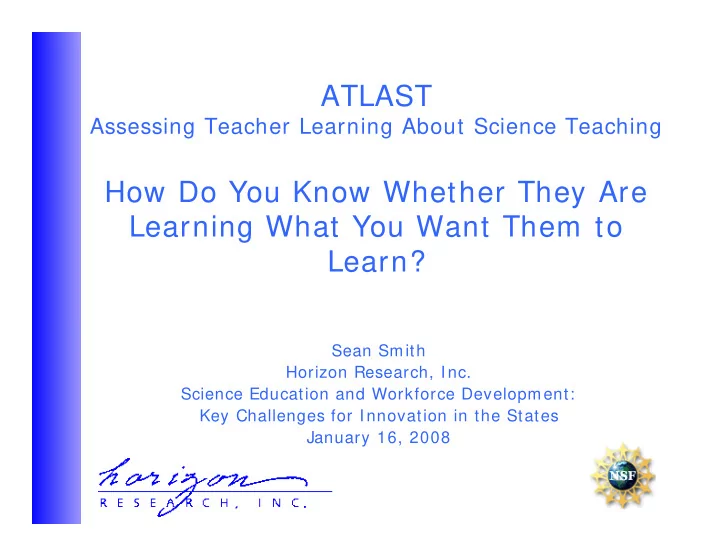

ATLAST Assessing Teacher Learning About Science Teaching How Do You Know Whether They Are Learning What You Want Them to Learn? Sean Smith Horizon Research, Inc. Science Education and Workforce Development: Key Challenges for Innovation in the States January 16, 2008
Domains of Teacher Knowledge • Disciplinary content knowledge • Student thinking about the content • Strategies to diagnose the thinking of a particular group of students • Sequencing ideas for students • Content-specific strategies that move students’ thinking forward
Situating Our Work • Force and motion • Flow of matter and energy in living systems • Plate tectonics
What Do Our Items Look Like?
In a unit on force and motion, students have been pushing small carts across their tables to the right and observing the motion. The teacher asks the students to draw a diagram showing all the horizontal forces on a cart once it leaves the student's hand and is rolling across the table. Which one of the following force diagrams is correct? (A)
Common Features of All Items • All are multiple choice • All are keyed to a specific idea • All are set in the context of work that teachers do
Another Type of Item
Level 2 Item Features • Address teachers’ ability to analyze student thinking using science content knowledge • Cannot be answered without content knowledge • Only one answer choice is “content- correct” and relevant to the instructional context • Fairly high cognitive load
Common Errors Made With Level 2 Items • Teachers look for common student thinking rather than the thinking of these students • Teachers look for a correct statement • Teachers try to answer the student item • Teachers look for familiar wording – e.g., “equal and opposite” • Teachers need options that allow them to hold naïve conceptions
A Third Type of Item
Level 3 Item Features • Address teachers’ ability to make instructional decisions using science content knowledge • Cannot be answered without content knowledge • Only one answer choice is “content- correct” and relevant to the instructional context • High cognitive load
Common Errors Made With Level 3 Items • Teachers see all activities/ questions as “best” – Lack of content knowledge – High cognitive load • Context is important – Focus on logistics – Unfamiliar scenario/ equipment • Teacher beliefs
Types of Items • Knowledge of science content • Using science content knowledge to analyze student thinking • Using content knowledge to make instructional decisions
Uses in Research and Evaluation
Simple Workshop Evaluation 7 0 6 0 5 0 4 0 Percent Pre- test Correct Post- test 3 0 2 0 1 0 0 Test Scores
7 0 6 0 5 0 4 0 Percent Correct 3 0 2 0 1 0 0 Pre- test Post- test Delayed Post- test
More Rigorous Evaluation 7 0 6 0 5 0 4 0 Percent Pre- test Correct Post- test 3 0 2 0 1 0 0 Control group W orkshop participants
The Link Between Teacher Knowledge and Student Learning 8 0 7 0 6 0 5 0 Percent 4 0 Correct 3 0 2 0 1 0 0 Pre-test w ith Post test Post-test Post-test avg teacher w ith teacher w ith average w ith teacher 1 S.D. below teacher 1 S.D. above m ean m ean
Consider…
In a lesson on plant growth, a teacher is discussing plants’ use of light energy from the Sun. During the discussion, one student says, “ Plants need the light to grow, but they don’t change the light at all. It’s like when you’re reading a book, and you need the light to help you read. ” Which one of the following ideas about the role of light energy in photosynthesis does the student seem to be missing? (B) A. Light energy is changed into sugars in the process of photosynthesis. B. Light energy is changed into another form of energy in the process of photosynthesis. C. Light energy is the energy source for the process of photosynthesis. D. None. The student seems to have an accurate understanding of the role of light energy in the process of photosynthesis.
In a class discussion, a teacher asks his students to describe Earth’s plates. One student says, “There are thousands of plates that are moving and causing changes to Earth’s surface.” Based on this statement, which one of the following should the teacher do next to further this student’s understanding of Earth’s plates? (B) A. Discuss the types of geological features plate movement can cause. B. Have students outline the boundaries of the plates on a map. C. Introduce students to the specific ways in which plates move. D. Demonstrate how the plates move as a result of convection.
1. A force is a push or pull interaction between two objects, and has both strength and direction. 2. The force of friction acts to oppose an object’s motion.
More recommend